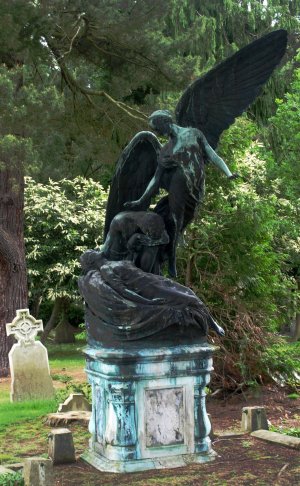
 |
| About the Cemetery |
 By the mid-nineteenth century the volume of London's dead was causing considerable public concern. In 1850, the idea of a great metropolitan cemetery, situated in the suburbs and large enough to contain all of London's dead for ever, was promoted. In 1850 an interested group formed the London Necropolis & National Mausoleum Company, established by Act of Parliament in June 1852. 2,000 acres of Woking's common land were purchased from Lord Onslow. Some 500 acres were initially planted out for the Cemetery at the western end of this estate. As Brookwood could be reached cheaply and conveniently only by railway, the London & South Western Railway was engaged to convey coffins and mourners from a private station adjacent to Waterloo down into the Cemetery. At Brookwood there were two stations, one for the Nonconformist sections, the other for the Anglican areas. Brookwood Cemetery was consecrated by the Bishop of Winchester on 7 November 1854 and opened to the public on 13 November 1854. In 1854, Brookwood was the largest Cemetery in the world. Today this is no longer true, but it remains the largest Cemetery in the UK, and is probably the biggest in Western Europe. Since 1854, some 235,000 people have been buried there. Plots were reserved for use by parishes (eg: St Anne's Soho), or by various guilds and organisations (eg: the Oddfellows' Society). Individuals had complete freedom over the site and position of their grave, provided they could afford the plot. The cemetery includes a remarkably rich range of burials reflecting all levels of society. Famous burials include those of Charles Bradlaugh (the first atheist to sit in the House of Commons); Dr Robert Knox (one of Burke and Hare's best customers); the artists John Singer Sargent, William and Evelyn De Morgan; and the locomotive engineer Dugald Drummond. Other burials include those of Mrs Edith Thompson (executed at Holloway Prison in 1923), St Edward the Martyr (a Saxon King of England), and Lord Edward Pelham-Clinton (sometime Master of Queen Victoria's household). Elsewhere lie thousands of Londoners buried at the expense of their parish in individual yet unmarked graves. The military cemeteries, separately administered by the Commonwealth War Graves Commission, were first used in 1917. They were extended substantially during and after the Second World War. The funeral trains stopped running after the London terminus was bombed in April 1941. The Glades of Remembrance, an area set aside for the reception of cremated remains, was opened in 1950. The Necropolis Company eventually relinquished its interest in the Cemetery (c.1970), and the grounds have changed hands several times since. The St Edward Brotherhood moved into the site of the former Anglican chapels in 1979. This monastic community serves the Church and shrine of St Edward the Martyr and tends a small Orthodox Christian cemetery. Brookwood is vast - almost rural - and is quite unlike any of the other London cemeteries it was designed to surpass and replace. The bold imaginative planting (which includes several avenues of giant sequoia) has now matured. The Cemetery deserves to be recognised as a site of local historical importance Brookwood Cemetery was privately owned and operated by Brookwood Park Limited until 2016. It is now owned by Woking Council. The Cemetery is still open for burials. For further information please see the company's website. |
| h Publications h |
h Free maps and guides to download h |